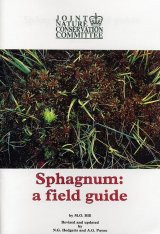Sphagna are distinctive mosses found in wet habitats in the British Isles, which formed most of the peat found in blanket bogs and raised bogs. This peat forms an important store of carbon.
There are 34 species of British Sphagna, which all share a few basic features:-
- a single stem ending in a capitulum
- side branches (both hanging and spreading) coming off the stem in groups known as fascicles
- stem and branch leaves made of a network of smaller, green, living cells and larger, clear dead cells which are able to hold a lot of water

There are a number of resources to help tell different sphagna apart. A good place to start is "Sphagnum: a field guide", published by the JNCC .
You will need a hand lens to use this guide properly, but once you get used to noticing key features such as stem leaf shape and orientation, using it becomes quicker.
This small booklet uses line drawings to show what features to look for and a key to identify species.
Unfortunately this guide is out of print, but in can be downloaded free from the Joint Nature Conservation Committee website.
Fringed Bog-moss
Fringed Bog-moss (Sphagnum fimbriatum) is a rather slender plant, with long branches and a terminal bud in the centre of the captitulum.
Pulling of the capitulum on a specimen lets you see the stem leaves, which are a useful guide to species. In this case, the stem leaves are spathulate and tattered.
Another useful feature helping to identify this moss as Fringed Bog-moss is the prominent terminal bud in the centre of the capitulum (compare with Flat-topped Bog-moss (Sphagnum fallax) below).
Flat-topped Bog-moss
Flat-topped Bog-moss (Sphagnum fallax) is s slightly more robust plant, with stem leaves which are triangular, not tattered and downward hanging.
Other guides
The Field Studies Council produces a laminated photograhic field guide, which you can buy on their website.
If you have a smartphone (either android or apple) you can download a free app called MoorMOSS from Moors For The Future, a guide to sphagnum and other moorland mosses.
You may also be interested in the British Bryological Society.
